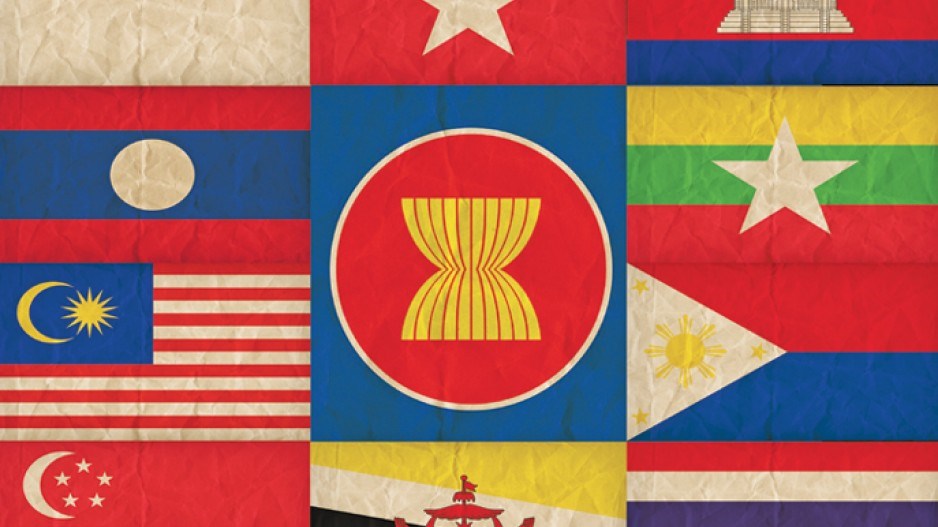The heavy scent of ever more enticing commercial opportunities hangs in the air over Southeast Asia these days, which is why this year's regional security summit attracted all the big beasts of international diplomacy.
Foreign ministers from the United States, the European Union, China, Russia, Japan and India hotfooted it a week ago to the Burmese capital, Naypyidaw, for the Association of Southeast Asian Nations Regional Forum (ARF). Normally attending the ARF is something the 18 partners of the 10 countries of the Association of Southeast Asian Nations (ASEAN) do only if there's nothing more interesting in the diary. Not these days, and, like others, Canadian Foreign Minister John Baird tried to draw attention to his presence by touring several ASEAN capitals and dispensing bounty on his way to the ARF.
The ARF was founded 37 years ago as a forum where ASEAN countries and their 18 partners from Asia and beyond try to tackle the security issues that made Southeast Asia one of the world's most conflict-prone regions for much of the last half of the 20th century.
Thus the $14 million in gifts Baird brought for his hosts were all for projects to enhance regional security. But the expectation is that Canada's demonstration of friendship and solidarity will pay off elsewhere.
The heady pheromones flowing from ASEAN these days stem from its plans to form an economic union similar to the European Union (EU) by the end of next year. There are still some doubts whether all the preliminary work and agreements necessary for the gestation of the ASEAN Economic Community (AEC) can be completed in time. Late last year the Asian Development Bank issued a pessimistic report on the chances of meeting the deadline.
But even if there are delays, the opportunities the AEC will present are too important for any potential partners to want to be left on the sidelines.
As the bank report put it: “The real test for the AEC will lie in the years beyond – in trade facilitation, liberalization of services, investment, labour mobility, competition policy, regional trade agreements and compliance, among others.”
To help meet those goals, the EU is offering its experience in setting up and managing an economic community made up, like ASEAN, of members with widely disparate economies, cultures and political styles. Brussels is putting up $227 million to support the development of AEC institutions from now until 2020. There is also the prospect of stalled ASEAN-EU free trade talks restarting after the AEC comes into being.
The AEC will be a commercial market of about 670 million people in the member states Brunei, Cambodia, Indonesia, Laos, Malaysia, Burma (also known as Myanmar), the Philippines, Singapore, Thailand and Vietnam. While China and Japan are aging, ASEAN has a young population with over two-thirds of the region's people under 35 years old.
The AEC will join the EU, the North American Free Trade Agreement area and individual markets like China and India as one of the world's premier free trade zones, and a top target for trade and investment.
Even before they amalgamate into one economic community, the ASEAN member nations are formidable actors on the trade stage. The combined gross domestic product of the ASEAN countries is expected to be $2.7 trillion this year, making it the world's eighth-largest economy. Predictions for GDP growth are around 5.4% this year.
That's in the same ballpark as India and not too far behind China, whose GDP growth may come in at 7% this year and in that range for several years to come if the next tranche of economic reforms is successful.
While successive governments in Ottawa have tended to be mesmerized by the hype that has enveloped economic growth in China and India, many individual Canadian companies and business people have seen Southeast Asia as a more attractive pond in which to fish.
As the 10 countries of the Association of Southeast Asian Nations (ASEAN) continue their drive to create an economic community like the European Union by the end of next year, Foreign Minister John Baird is reinvigorating Canada's relations with the region. To a degree he is building on the vigorous presence already established in ASEAN by Canadian businesses.
Over the past five years Canadian bilateral trade with ASEAN countries has grown by more than 30%. ASEAN is now Canada's seventh-largest merchandise trade partner, and two-way commerce reached $17 billion last year.
At the same time, the countries of ASEAN are a favourite investment target for Canadians. Last year Canadian investment in the region was just over $6 billion, $1 billion more than Canada's investment in China and India combined.
There are problems. A survey last year by the Asia Pacific Foundation of Canada found that 67% of those polled said corruption was among the top three of the barriers to doing business in ASEAN. And 60% said inconsistent laws and regulations are daunting.
But the survey found the overall view is upbeat. Close to 90% of companies said their operations in ASEAN are profitable, and half said their investments made money within three years. Over 60% said they expect their operations to be even more profitable this year.
According to 81% of those polled, ASEAN continues to have many investment opportunities, and the same proportion said they plan to increase their investments in the region. The top targets for business and investment are Indonesia (21%), Philippines (13%), Malaysia (12%) and Singapore (11%).




